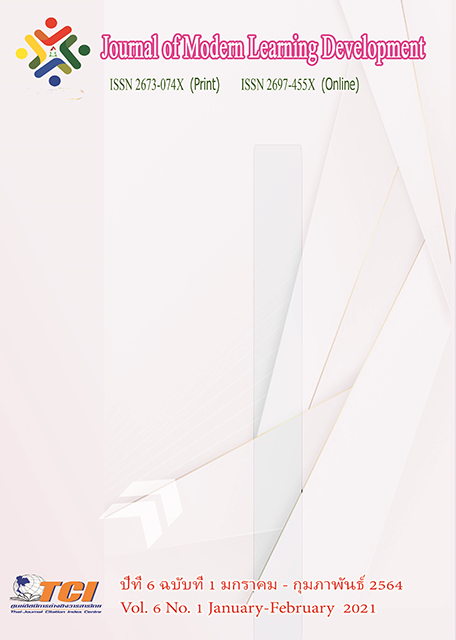The Use of Authentic Materials in Translation Learning: Thai Learners’ Perceptions of the Learning Experince
Main Article Content
Abstract
Scholars have proved that the authentic learning material was not only beneficial and vital to language classes, but in translation field also perceived such a material provides advantages to the learners. This qualitative study aims to determine the perceptions of Thai students on the use of authentic materials in the translation class emphasizing on the benefits and difficulties in using the materials in learning translation. Ten English major students at one university in Thailand, were participated in the study by their willingness and consent. The authentic materials were used in the conducted class that the participants needed to learn translation with the materials for twelve weeks. They also needed to go through the process of writing the reflective journals to reflect on their own learning, and also attended the semi-structure interview. The data were analyzed using content analysis and open-axial coding techniques. The results suggested the participants perceived the authentic materials could help enhancing their English language and translation skills. They also learned how to use the particular word suitably in the specific context. However, the participants faced the difficulties regarding to some technical terms and the complex sentence structures in the materials. Overall, the participants perceived both benefits and difficulties using the material in translation class.
Article Details
References
Ahmed, (2017). Authentic ELT Materials in the Language Classroom: An Overview. Journal
of Applied Linguistics and Language Research. 4 (2), 181-202.
Beresovaa, J. (2015). Authentic Materials – Enhancing Language Acquisition and Cultural Awareness. Social and Behavioral Sciences. 192, 195 – 204.
Boonkaew, C. (2018). A Case Study of Thai EFL College Students’ Perceptions on an Autonomous Learning Model in Learning English Pronunciation. Master Degree Dissertation, Mahidol University, Nakornphrathom, Thailand.
Cheoythong, A. (2009). Factor Affecting Learner Use of a Self-Access Center. Master Degree
Dissertation, Mahidol University, Nakornphrathom, Thailand.
Cook-Sather, A. (2009). “I Am Not Afraid to Listen”: Prospective teachers learning from students. Theory into Practice. 48 (3), 176-183.
Cook-Sather, A. (2010). Through Students’ Eyes: Students offer fresh insights into social justice issues in schools. JSD. 31(4), 42-45.
Dewey, J. (1944). Democracy and Education. New York: Free Press.
Galan-Manas, A. (2011). Translating Authentic Teaching Documents in Specialized Translation Classes. Jostrans. The Journal of Specialized Translation. 16, 109-125.
Halim, A. & Mukminatien, N. & Anugerahwati, M (2018). The Students’ Perceptions
towards Authentic Materials for Reading and Listening Activities. Getsempena English Education Journal. 5 (2),150-161.
Hayikaleng, N. (2019). The Effects of Using Authentic Materials on Students’ Achievement
towards English Reading Comprehension among Narathiwat Technical College Students. International Journal of Arts Humanities and Social Sciences Studies. 4 (7),21-27.
Kuucua, S. & Unlua, S. (2015). Teaching Translation: A Suggested Lesson Plan on Translation of Advertising Through the Use of Authentic Materials. Social and Behavioral Sciences.
Nottingham, J. E. (1998). Using Self-Reflection for Personal and Professional Development in Student Affairs. New Directions for Students Services. 84, 71-81.
Noowong, P. & Sukseemuang, P. (2017). Effects of Using Authentic Materials on English Vocabulary Knowledge and Vocabulary Retention of Grade 11 Students. Parichart Journal Thaksin University, special issue. 30 (3),208-215
Poonsawat, U. (2017). The Use of Authentic Materials Among Thai Teachers in Intensive English Programs. Master Degree Dissertation, Thammasat University, Thailand
Rao, S.P. (2019). The Effective use of Authentic Materials in the English Language Classrooms. Online. Retrieved December 25, 2020. from http://www. researchgate. net/publication/334187595
Rodgers, C. (2002). Defining Reflection: Another Look at John Dewey and Reflective Thinking. Teachers College Record. Columbia University. 104 (4), 842-866.
Rusiana, (2017). The Students’ Perceptions of Authentic Text-Based Translation. Okara: Journal Bahasa dan Sastra, 11 (2), 231-242.
Suryawan, I. N. (2013). Methods of Translation Used in Translating Authentic Text of Obyek Wisata Panelokan into Panelokan Tourist Resort. Online. Retrieved December 25, 2020 from: udayana.academia.edu/NengahS uryawan/Papers.
Susendi, Y. A. & Syafei, R. F. (2017). Using Authentic Material to Teach Translation to English Department Students. Journal of English Language Teaching. 6 (1), 221-231
Yelubayeva, P. (2019). Authentic Materials in English Language Classrooms. Online. Retrieved December 25, 2019. From: http://www.researchgate.net/publication/33134 6201
Wesely, M. P. (2012). Learner Attitudes, Perceptions, and Beliefs in Language Learning. Foreign Language Annals. 45 (51), 98-117.


